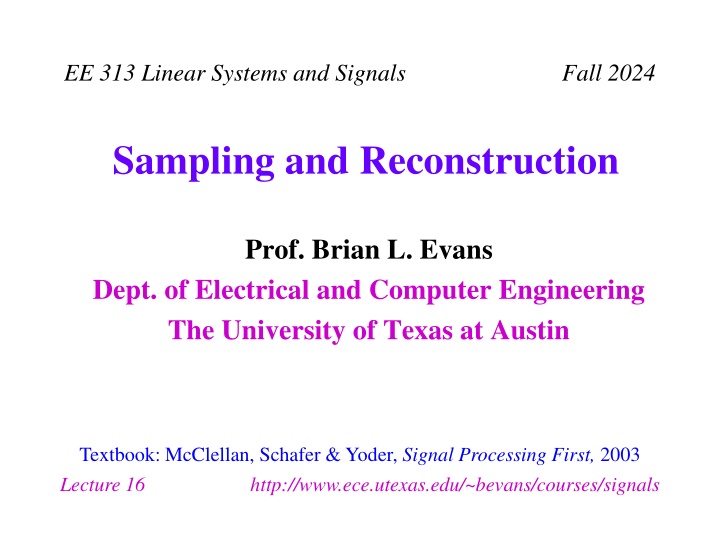
Sampling and Reconstruction in Signal Processing - EE 313 Lecture Summary
Explore the fundamentals of sampling and reconstruction in signal processing through topics such as continuous-time Fourier transform, sampling theory in time and frequency domains, and reconstruction methods. Join Prof. Brian L. Evans' lecture for a comprehensive understanding using the textbook "Signal Processing First" by McClellan, Schafer, & Yoder.
Download Presentation

Please find below an Image/Link to download the presentation.
The content on the website is provided AS IS for your information and personal use only. It may not be sold, licensed, or shared on other websites without obtaining consent from the author. If you encounter any issues during the download, it is possible that the publisher has removed the file from their server.
You are allowed to download the files provided on this website for personal or commercial use, subject to the condition that they are used lawfully. All files are the property of their respective owners.
The content on the website is provided AS IS for your information and personal use only. It may not be sold, licensed, or shared on other websites without obtaining consent from the author.
E N D
Presentation Transcript
EE 313 Linear Systems and Signals Fall 2024 Sampling and Reconstruction Prof. Brian L. Evans Dept. of Electrical and Computer Engineering The University of Texas at Austin Textbook: McClellan, Schafer & Yoder, Signal Processing First, 2003 Lecture 16 http://www.ece.utexas.edu/~bevans/courses/signals
Continuous-Time Fourier Transform SPFirst Ch. 12 Intro Linear Systems and Signals Topics Domain Time Topic Signals Systems Convolution Fourier series Fourier transforms Frequency response z / Laplace Transforms Transfer Functions System Stability Sampling Discrete Time SPFirst Ch. 4 SPFirst Ch. 5 SPFirst Ch. 5 ** SPFirst Ch. 6 SPFirst Ch. 6 SPFirst Ch. 7-8 SPFirst Ch. 7-8 SPFirst Ch. 8 SPFirst Ch. 4 Continuous Time SPFirst Ch. 2 SPFirst Ch. 9 SPFirst Ch. 9 SPFirst Ch. 3 SPFirst Ch. 11 SPFirst Ch. 10 Supplemental Text Supplemental Text SPFirst Ch. 9 SPFirst Ch. 12 Frequency Generalized Frequency Mixed Signal ** Spectrograms (Ch. 3) for time-frequency spectrums (plots) computed the discrete-time Fourier series for each window of samples. 16-2
Sampling & Reconstruction SPFirst Sec.12-3.1 Sampling: Time Domain Many signals originate in continuous-time Talking on cell phone, or playing acoustic music By sampling continuous-time signal at isolated, equally-spaced points in time, we obtain a sequence of numbers Ts is sampling period (Ts = 1 / fs) f(t) Sampler at sampling rate of fs ( ) t fsampled n ( ) = sT f f n Ts n {..., -2, -1, 0, 1, 2, ...} t Ts ( ) t ( ) = n = ( ) T f f t t n f(t) sampled s Sampled analog waveform impulse train 16-3
Sampling & Reconstruction SPFirst Sec.12-3.2 Sampling: Frequency Domain Sampling replicates spectrum of continuous-time signal at integer multiples of sampling frequency Fourier series of impulse train s = 2 fs = 1 Ts = 1 Ts SPFirst Ex. 11-4 p. 321 d t-nTs ( n=- ) 1+2cos(wst)+2cos(2wst)+... ( ) dTs(t)= ( ) f(t)+2f(t)cos(wst)+2f(t)cos(2wst)+... g(t)= f(t) dTs(t) Modulation by cos( st) Modulation by cos(2 st) F(j ) G(j ) 1 Ts 1 How to recover F(j )? -2 fmax 2 fmax s s s 2 if s f s gap if and only 2 2 2 f f f f max max max s 16-4
Sampling & Reconstruction SPFirst Sec.12-3.3 Reconstruction Revisiting bandlimited example on previous slide f(t) g(t) F(j ) G(j ) 1 Ts 1 Sampler at sampling rate of fs -2 fmax Apply lowpass filter H(j ) to G(j ) to recover F(j ) 2 fmax s s s s Sampling Theorem ws>2wmax so wmax<1 H(j ) 2ws 1 h(t) Ts F t s s s s Ts 0 -2Ts Impulse response lasts for < t< -Ts 2Ts3Ts -1 1 2ws 2ws sin( t/Ts) / ( t/Ts) Ts rect( / s) 16-5
Sampling & Reconstruction SPFirst Sec.4-1, 4-2 & 12-3 Sampling Theorem Continuous-time signal x(t) with frequencies no higher than fmax can be reconstructed from its samples x(n Ts) if samples taken at rate fs > 2 fmax Nyquist rate = 2 fmax Nyquist frequency = fs / 2 Example: Sampling audio signals Normal human hearing is from about 20 Hz to 20 kHz Apply lowpass filter before sampling to pass low frequencies up to 20 kHz and reject high frequencies Lowpass filter needs 10% of maximum passband frequency to roll off to zero (2 kHz rolloff in this case) 16-6
Sampling & Reconstruction SPFirst Sec. 4-4.1, 12-3.3 & 12-3.4 Discrete-to-Continuous Conversion General form of interpolation is sum of weighted pulses = n ~ = ( ) [ ] ( sn T ) y t y n p t Input: discrete-time sequence y[n] Output: continuous-time signal that is an approximation of y(t) Pulse function p(t) Unit amplitude and/or unit area Rectangular, triangular, sinc, truncated sinc, etc. Overlaps in time with other pulses when duration > Ts 16-7
Sampling & Reconstruction SPFirst Sec. 4-4.6, 11-4.2, 12-3.3 & 12-3.4 Ideal Bandlimited Interpolation Plot of pulse p(t) Sinc pulse sinp p Ts t Ts = 1; t = -5 : 0.01 : 5; p = sinc(t/Ts); plot(t, p) Ts t p(t)=sinc = Ts t In time, infinite overlap with other sinc pulses Interpolate in time w/ infinite extent pulse? Make it finite in extent Truncate sinc pulse by multiplying it by rectangular pulse t Ts Interpolation 16-8
